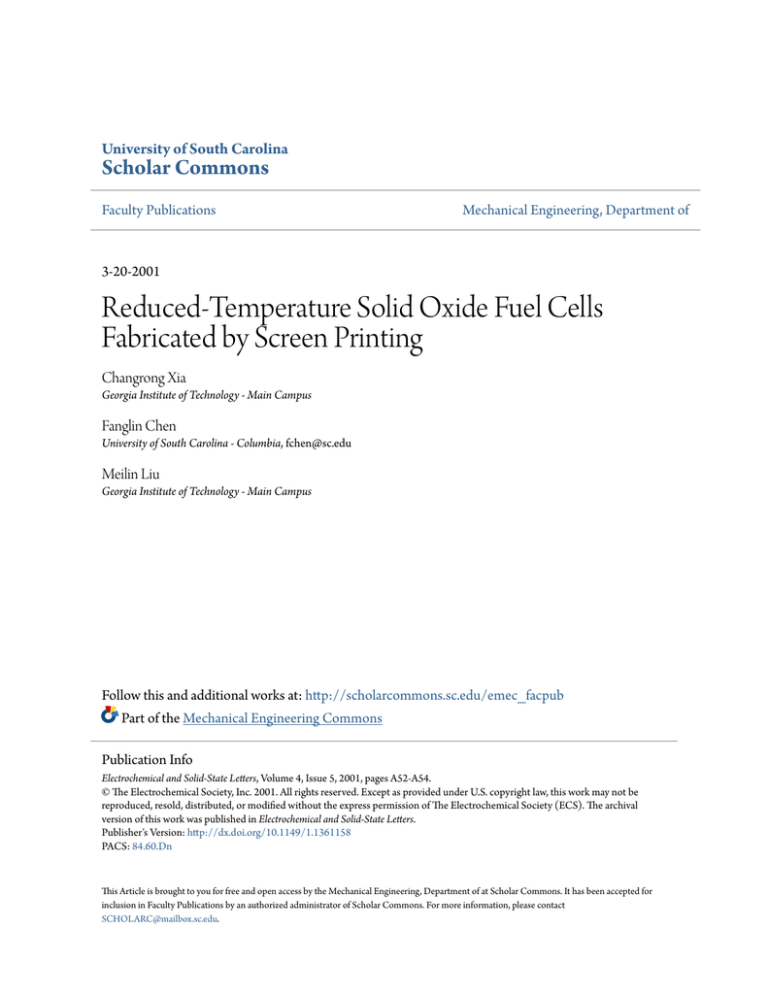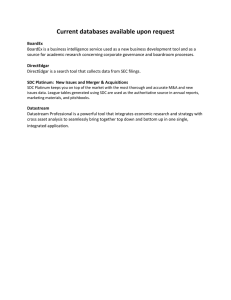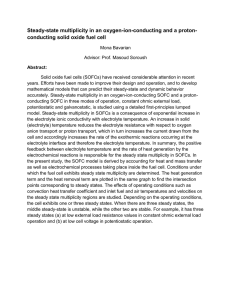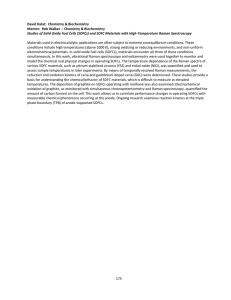
University of South Carolina
Scholar Commons
Faculty Publications
Mechanical Engineering, Department of
3-20-2001
Reduced-Temperature Solid Oxide Fuel Cells
Fabricated by Screen Printing
Changrong Xia
Georgia Institute of Technology - Main Campus
Fanglin Chen
University of South Carolina - Columbia, fchen@sc.edu
Meilin Liu
Georgia Institute of Technology - Main Campus
Follow this and additional works at: http://scholarcommons.sc.edu/emec_facpub
Part of the Mechanical Engineering Commons
Publication Info
Electrochemical and Solid-State Letters, Volume 4, Issue 5, 2001, pages A52-A54.
© The Electrochemical Society, Inc. 2001. All rights reserved. Except as provided under U.S. copyright law, this work may not be
reproduced, resold, distributed, or modified without the express permission of The Electrochemical Society (ECS). The archival
version of this work was published in Electrochemical and Solid-State Letters.
Publisher's Version: http://dx.doi.org/10.1149/1.1361158
PACS: 84.60.Dn
This Article is brought to you for free and open access by the Mechanical Engineering, Department of at Scholar Commons. It has been accepted for
inclusion in Faculty Publications by an authorized administrator of Scholar Commons. For more information, please contact
SCHOLARC@mailbox.sc.edu.
Electrochemical and Solid-State Letters, 4 共5兲 A52-A54 共2001兲
A52
1099-0062/2001/4共5兲/A52/3/$7.00 © The Electrochemical Society, Inc.
Reduced-Temperature Solid Oxide Fuel Cells Fabricated
by Screen Printing
Changrong Xia, Fanglin Chen,* and Meilin Liu,**,z
School of Materials Science and Engineering, Georgia Institute of Technology, Atlanta,
Georgia 30332-0245, USA
Electrolyte films of samaria-doped ceria 共SDC, Sm0.2Ce0.8O1.9) are fabricated onto porous NiO-SDC substrates by a screen
printing technique. A cathode layer, consisting of Sm0.5Sr0.5CoO3 and 10 wt % SDC, is subsequently screen printed on the
electrolyte to form a single cell, which is tested at temperatures from 400 to 600°C. When humidified 共3% H2O) hydrogen or
methane is used as fuel and stationary air as oxidant, the maximum power densities are 188 共or 78兲 and 397 共or 304兲 mW/cm2 at
500 and 600°C, respectively. Impedance analysis indicates that the performances of the solid oxide fuel cells 共SOFCs兲 below
550°C are determined primarily by the interfacial resistance, implying that the development of catalytically active electrode
materials is critical to the successful development of high-performance SOFCs to be operated at temperatures below 600°C.
© 2001 The Electrochemical Society. 关DOI: 10.1149/1.1361158兴 All rights reserved.
Manuscript submitted November 13, 2000; revised manuscript received January 10, 2001. Available electronically March 20,
2001.
A solid oxide fuel cell 共SOFC兲 is one of the cleanest, most efficient, and versatile technologies for chemical-to-electrical energy
conversion. While existing SOFC technology has demonstrated
much higher energy efficiency with minimal pollutant emission over
conventional energy technologies, the cost of the current SOFC systems is still prohibitive for broad commercialization except for a
small niche market. To be economically competitive, both the cost
of materials and the cost of fabrication for SOFC systems must be
dramatically reduced. One effective approach to cost reduction is to
reduce the operating temperature. For example, if the operating temperature of SOFCs can be reduced to 400-600°C, the interconnect,
heat exchangers, and structure components may be fabricated from
relatively inexpensive metal components.1,2 Accordingly, extensive
efforts have recently been focused on reduced-temperature SOFCs.
Doshi et al. reported a maximum power density of 140 mW/cm2 at
500°C for a H2/air fuel cell based on a thin film GCO
(Gd0.2Ce0.8O1.9兲 electrolyte with a Ni-GCO anode and an ANLC-1
cathode.3 The anode-supported cell was prepared by a multiplayer
tape-casting technique. The total cell resistance at 500°C was 1.3 ⍀
cm2, of which 0.7 ⍀ cm2 was attributed to the electrolyte and nearly
0.6 ⍀ cm2 to the cathode, while the polarization of the anode was
negligible. Barnett et al.4 reported a direct electrochemical oxidation
of methane in SOFCs that generated power densities up to 370, 250,
and 125 mW/cm2 at 650, 600, and 550°C, respectively. The electrolyte film, an 8 m thick YSZ, was prepared on a La0.8Sr0.2MnO3
cathode using magnetron sputtering.
To significantly reduce the cost of fabrication, we have studied
screen printing for fabrication of SOFCs based on an SDC
(Sm0.2Ce0.8O1.9) electrolyte film, a cermet anode consisting of SDC
and NiO, and a composite cathode consisting of Sm0.5Sr0.5CoO3 and
10% SDC. Compared with the film preparation techniques mentioned earlier, screen printing is simple and cost effective.1 It has
been extensively used for the preparation of electrolytes with thickness varying from a few tens of micrometers to about 200 m. In
this article, we report our initial results on SOFCs based on SDC
electrolyte fabricated using screen printing and characterized at temperatures from 400 to 600°C. The observed power densities and the
interfacial resistances are impressive at these low temperatures,
while the detailed electrochemical characteristics of the cells, especially the interfacial phenomena, are still under investigation.
* Electrochemical Society Student Member.
** Electrochemical Society Active Member.
z
E-mail: meilin.liu@mse.gatech.edu
The SDC electrolyte powder and the cathode material
(Sm0.5Sr0.5CoO3) were prepared by a glycine/nitrate process.5-7 The
anode pellets were prepared from a mixture of NiO and SDC powder at a weight ratio of NiO:SDC ⫽ 65:35. The mixed powder was
pressed under 2 ⫻ 108 Pa into a pellet 共10 mm diam and 0.3-0.5
mm thick兲. An electrolyte slurry consisting of SDC powder,
methylcellulose, terpineol, and ethanol was screen printed onto the
green anode pellet and subsequently fired at 1350°C in air for 5 h.
The temperature was increased at a rate of 120°C/h up to the firing
temperature, pausing for 60 min at 450°C to remove organics. A
cathode slurry consisting of Sm0.5Sr0.5CoO3, 10 wt % SDC, and a
Heraeus binder 共V006兲 was also applied to the electrolyte by screen
printing. The cathode was fired at 950°C in air for 4 h with heating
and cooling rates of 300°C/h. Shown in Fig. 1 are the microstructures of each cell component as characterized using a scanning electron microscope 共SEM, Hitachi S-800兲. The SDC electrolyte layer
共with thickness of 30 m兲 is dense while both anode and cathode are
porous. The porosities of the cathode and anode are 27 and 35%,
respectively, as estimated from quantitative microscopy.
The single cell was sealed on an alumina tube support with silver
paste 共Heraeus, C8710兲. The cell was horizontally mounted into an
electric furnace. Electrochemical characterizations were performed
at ambient pressure at temperatures from 400 to 600°C. Fuel cell
performances were measured with an EG&G potentiostat/
galvanostat 共model 273A兲 interfaced with model 270/250 Research
Electrochemistry software. Humidified 共3% H2O兲 hydrogen or methane was used as fuel and stationary air was used as oxidant. The
impedances of the cell under open-circuit conditions were measured
with an EG&G lock-in amplifier 共model 5210兲 and an EG&G
potentiostat/galvanostat 共model 273A兲 interfaced with model 398
electrochemical impedance software.
Shown in Fig. 2 are the I-V curves and the corresponding power
densities for an SOFC tested at temperatures from 400 to 600°C
with humidified hydrogen as fuel. Each datum point was recorded
about 30 min after the cell reached the steady state. As shown in
Fig. 2, an open-circuit voltage 共OCV兲 of 1.02 V was observed at
400°C indicating that the electronic condition in SDC is insignificant. The maximum power densities were 128, 188, 240, and 397
mW/cm2 at 450, 500, 550, and 600°C, respectively. Although fuel
cells based on SDC electrolyte that were 0.25-0.50 mm thick have
been tested at temperatures above 600°C,8 the performance of the
SOFCs below 600°C is not available in the literature. The observed
current and power densities at low temperatures 共400-600°C兲 of the
fuel cells fabricated by screen printing represent significant progress
in low-temperature SOFCs.
Figure 3a shows the impedance spectra of a single cell with
humidified hydrogen as fuel, while in Fig. 3b the interfacial polar-
Downloaded 22 Jun 2011 to 129.252.106.156. Redistribution subject to ECS license or copyright; see http://www.ecsdl.org/terms_use.jsp
Electrochemical and Solid-State Letters, 4 共5兲 A52-A54 共2001兲
A53
Figure 1. Cross-sectional view 共SEM graphs兲 of 共a兲 a single cell, 共b兲 the porous Ni-SDC anode, 共c兲 the dense SDC electrolyte, and 共d兲 the porous
Sm0.5Sr0.5CoO3 ⫹ 10 wt % SDC cathode.
ization resistance and electrolyte resistance as determined from the
impedance spectra are shown. At temperatures below 550°C, the
interfacial resistance is much greater than the resistance of the electrolyte. The ratio of interfacial resistance to electrolyte resistance
increased dramatically as the operating temperature was reduced,
implying that the performance of the SOFCs to be operated at low
temperatures depends critically on the interfacial resistance. Accordingly, the development of catalytically active electrodes and interfaces is critical to successful development of SOFCs to be operated
at low temperatures 共⬍600°C兲. Mesoporous mixed-conducting electrodes and nanostructured interfaces may significantly improve the
performance of low-temperature SOFCs.
It is noted that the interfacial polarization resistance was 1.0 ⍀
cm2 at 500°C, about two-thirds the cell resistance, but reduced to
0.07 ⍀ cm2 at 600°C, only about one-sixth of the total cell
resistance. This implies that the cell performance at temperatures
above 600°C can be significantly improved by reducing the thickness of the electrolyte, at these temperatures both the cathode
(Sm0.5Sr0.5CoO3 and 10 wt % SDC兲 and the anode 共NiO and 35 wt
% SDC兲 are sufficiently active. For example, the cell performance at
600°C may be increased by 100% by reducing the electrolyte thickness from 30 to 10 m because the total cell resistance may be
reduced from 0.48 to 0.24 ⍀ cm2.
When humidified methane was used as fuel, the maximum power
densities were 78, 195, and 304 mW/cm2 at 500, 550, and
600°C, respectively, as is shown in Fig. 4. The power density
at 600°C 共304 mW/cm2兲 observed in this work is higher than those
Downloaded 22 Jun 2011 to 129.252.106.156. Redistribution subject to ECS license or copyright; see http://www.ecsdl.org/terms_use.jsp
A54
Electrochemical and Solid-State Letters, 4 共5兲 A52-A54 共2001兲
Figure 2. Cell voltages 共solid symbols兲 and power densities 共open symbols兲
as a function of current densities for an SOFC with humidified (3% H2O)
hydrogen as fuel at temperatures from 400 to 600°C.
Figure 4. Cell voltages 共solid symbols兲 and power densities 共open symbols兲
as a function of current densities for an SOFC with humidified (3% H2O)
methane as fuel at temperatures from 450 to 600°C.
obtained with SOFCs based on thin film 共8 m thick兲 YSZ prepared by magnetron sputtering 共250 mW/cm2兲.4
Acknowledgment
This work was supported by the National Science Foundation,
under award no. CTS-9819850, and by the Georgia Tech Molecular
Design Institute, under prime contract N00014-95-1-116 from the
Office of Naval Research.
The Georgia Institute of Technology assisted in meeting the publication
costs of this article.
References
Figure 3. 共a兲 Impedance spectra of an SOFC (Ni-SDC/SDC/
Sm0.5Sr0.5CoO3) as measured under open-circuit conditions when humidified
H2 was used as fuel and air as oxidant at 500, 550, and 600°C. 共b兲 Electrolyte
resistance, interfacial polarization resistance, and total cell resistance as determined from the impedance spectra shown in 共a兲.
1. J. Will, A. Mitterdorfer, C. Kleinlogel, D. Perednis, and L. J. Gauckler, Solid State
Ionics, 131, 79 共2000兲.
2. J. P. P. Huijsmans, F. P. F. van Berkei, and G. M. Christic, J. Power Sources, 71,
107 共1998兲.
3. R. Doshi, Von L. Richards, J. D. Carter, X. Wang, and M. Krumpelt, J. Electrochem. Soc., 146, 1273 共1999兲.
4. E. P. Murray, T. Tsai, and S. A. Barnett, Nature 400, 649 共1999兲.
5. L. A. Chick, L. R. Pedersen, G. D. Maupin, J. L. Bates, L. E. Thomas, and G. J.
Exarhos, Mater. Lett., 10, 6 共1990兲.
6. N. J. Hess, G. D. Maupin, L. A. Chick, D. S. Sunberg, D. E. Mccreedy, and T. R.
Armstrong, J. Mater. Sci., 29, 1873 共1994兲.
7. M. W. Murphy, T. R. Armstrong, and P. A. Smith, J. Am. Ceram. Soc., 80, 165
共1997兲.
8. C. Milliken, S. Guruswamy, and A. Khandkar, J. Electrochem. Soc., 146, 872
共1999兲.
Downloaded 22 Jun 2011 to 129.252.106.156. Redistribution subject to ECS license or copyright; see http://www.ecsdl.org/terms_use.jsp





